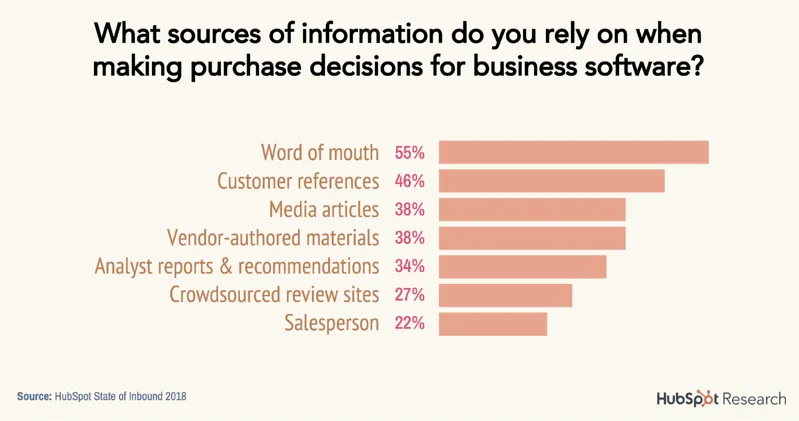How to Advocate for the Value of Referral Marketing
Even if you fully understand the value of referral marketing and the impact it can have on your business, implementing a new piece of software can require buy-in from multiple people and departments within your organization.
We’re here to help you answer the most common questions about why referral marketing should be a priority for any digital business looking to grow. Whether you’re trying to push forward with a tightened marketing budget, or have questions around how to support your unique customer journey, let us help you advocate for the value of referral marketing.
Keep reading for the 5 most common questions about the value of referral marketing and how to answer them.

Their question: We can just build a referral program ourselves. Why should we pay someone else to build it?
At first glance, building your own customer referral program seems like a simple option. You can customize every feature, don’t need to rely on a third-party vendor, and all you need is a way to collect customer information, track referrals, and give out rewards...right?
From years of experience in the customer referral market, we’ve learned the program components that mean the difference between failure and success. User widgets, support agent tools, analytics, advanced conversion rules, and continual upgrades are just a few of them.
Building a functional referral program is one thing, but without tools and an interface that your whole team can use to maintain and update your referral programs, you’ll end up with an overworked development team, a confused front-line team, and a frustrated marketing team who can’t make changes quickly enough.
When all of the tools and expertise you need to run a world-class referral program are already available to you with a vendor like SaaSquatch, you can let your team focus on your value proposition and competitive advantages, and let a dedicated set of experts take care of your referral and loyalty programs.
To learn more about whether you should build or buy your customer referral software, check out this article.
Their question: Customers are going to refer friends anyway if they want to. Why should we bother formalizing it?
While word-of-mouth promotion likely happens naturally for your business, we’ve seen incredible results from companies who choose to formalize referrals and tie incentives to the process.
For example, leading online pension provider PensionBee started seeing 5x more customer referrals since implementing a referral solution with SaaSquatch. While they had always acquired customers through referrals, automatically rewarding advocates lets them supercharge this channel in a way that isn’t possible manually.
Take a look at your conversion rates per channel, and you’ll likely see that word-of-mouth referrals convert at a higher rate, and are faster to close than most other channels. If it’s cheaper and more effective, why not make it a priority?
Plus, a study from Texas Tech found that 83% of consumers are willing to refer a customer after a positive experience, but only 29% actually do. Why miss out on revenue from the referrals of 71% more customers by not providing them with a simple and rewarding way to invite friends?
Their question: Why do we need our customers to convince people to buy? That’s what our sales team is for.
When consumers can browse endless reviews and comparisons online, salespeople often end up being their least trusted source of information when making purchase decisions. A study from Neilsen revealed that 92% of consumers trust recommendations from family and friends above all other forms of advertising.
With growing concerns around fake news, targeted advertising, and questionable uses of consumer data, it’s no surprise that customers are becoming more and more skeptical when presented with your company’s marketing message.
Simply put, consumers place more trust in the opinions of their friends and colleagues than your sales team, making your customers one of your most powerful acquisition tools.
Their question: Our sales cycle is long and complex and we’re much more than a simple e-store -- how do we design a referral program that can support us?
If you have complicated business requirements and a customer journey with more than just one touch point, you’re right that not just any referral program will do. A referral program built for an e-store won’t engage customers and prospects in the way you need to drive sales.
That’s why the SaaSquatch platform lets you build custom, multi-objective referral programs to set small goals throughout the buyer’s journey where both the promoter and referred customer can be rewarded at different milestones.
By defining various checkpoints throughout the sales process, you can reward advocates early on, and increase your chances of getting the sales process started and completed by a new customer.
For example, a multi-objective referral program for a CRM software platform might look like this:
Objective 1: When an existing customer refers a qualified lead who completes a product demo, give the existing customer a $25 gift card.
Objective 2: When the referred customer signs an annual contract, reward both the new and referring customer with a $100 gift card.

Read more about how a multi-objective referral program can work for you, or talk to us about how we can help support your unique business needs.
Their question: Our marketing budget recently got cut so why should we spend money on a new platform right now?
Referral marketing is actually one of your most cost-effective options for new customer acquisition, and is especially valuable when regular means of advertising are only getting more expensive, and less effective.
Instead of trying to beat out competitors on costly pay-per-click ads, consider engaging your existing users to advocate on your behalf. Here are a few reasons why:
- Referred customers cost less to acquire: Habito, an online leading mortgage broker, acquires customers at a 45% chapter rate using a SaaSquatch referral program.
- Referred customers are more loyal: A study from the Journal of Marketing reveals that referred customers are 18% more loyal, spend 13.2% more and have 16% higher lifetime values than non-referred customers.
If your marketing budgets are being reduced, your existing customers are the acquisition tool that you need to start utilizing. Don’t miss out on a valuable opportunity for growth.
